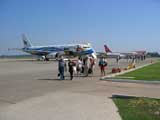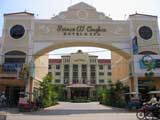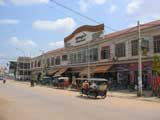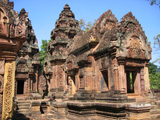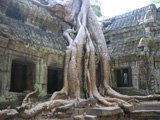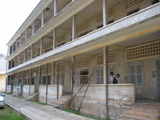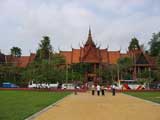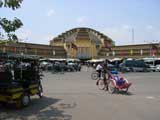 |
Cambodia has a surface of 181.040 square kilometers and is mostly made up of an alluvial basin crossed by a large number of rivers. During the rain season a twentieth of the country surface is covered by the waters of Tonle Sap lake, that during this period reaches its greatest extension of 10 thousand square kilometers, and is linked by the effluent with the same name to the great Mekong River, which with its affluents has a vital importance for the economy of the country. Ranges are not so high; the highest peak is Phnom Aural (1.771 meters), which includes the mountain range of Cardamomo, in the south. The nine tenth of the population (12 millions 500 thousand inhabitants) belong to the khmer ethnical group, and the remaining tenth is formed by chinese and vietnamese minorities, by the ethnical group cham and by tribes from the hills. 95% of the population follows the theravada buddhism, with some form of animism and of ancestors' cult; the Cham from their side are muslim. Cambodia is a Constitutional Monarchy, and the elected government is in office for 5 years. The average yearly income is only 285 USD per capita, and this makes Cambodia one of the poorest countries in the world; the average life expectation is only 57 years.
Though much less visited then the neighbour countries as Thailand, Vietnam and Laos, Cambodia is rapidly imposing itself as a touristic destination in the itineraries of the south-east Asia. The Angkor temples are the main attractions of the visitors, but the country has much more to offer: golden and still natural beaches, incontaminated forests, a mild climate and a relaxed atmosphere. With all the beauties of nature and its rich artistic heritage, in the recent past Cambodia lived a tragic period because of the movement of fanatics Khmer Rouge: the population had first to tolerate a genocide, when the Khmer Rouge took the power in the '70ies, and then an uninterrupted guerrilla that ended only in 1998. Nowadays, at last, the whole country is in peace, even if the aftereffects of the tragedy are still painfully evident in the lack of infrastructures, of streets in very bad conditions, of damaged buildings and above all of the huge number of disabled people due to anti-personnel mines. Much has still to be done before the country starts to be autonomous: Cambodia still dipends from the international helps and it will take a long period before most of the people can enjoy the tangible improvement of qulaity of life.
To the citizens of all nationalities (with the exception of Malay) a Visa is requested to visit Cambodia. Visas are issued at the arrival in the international airports of Siem Reap and Phnon Penh, and at the border stations of Poipet and Koh Kong. The individual touristic Visa (USD 20 plus photo) is valid 30 days including the issue day, and can be extended only once for a month. Besides the local currency, the riel, Cambodia has included the US dollar in its economy, a situation that started with UNTAC in the early '90ies, when the soldiers that stationed in the country started to spend their salaries in dollars. Nowadays it is possible to use indifferently either riels or dollars, with very few exceptions. Riel coins do not exist: notes start from 50 riel to 100 thousand riel.
The area that surrounds the current chief town of Siem Reap province, located 235 kilometers north-west from Phnom Penh, was once upon a time the heart of Khmer empire, that started in 802, when Jayavarman II moved to Phnom Kulen, and ended when the Siamese sacked Angkor Thom in 1431. Thanks to the abundance of water and the fertility of the land, the region could sustain a large population, the kings of Angkor built here their royal towns and their state temples. During the centuries the Khmer waged war on border reigns and vice versa and the empire reached the height of the power under King Jayavarman VII (the greatest builder of temples), when it spread to the east until the coast of Vietnam, to the south until the malay coast , to the west until Pagan, in Burma, to the north untiel Laos. Neverthess, this part of Cambodia, abandoned by the court in the XV century, was completely forgotten till the end of the XVIII century, when, as part of the province of Battambang, it was occupied by Siam (the present Thailand). This state of things went ahead until 1907, the year when the French negotiated its return to the cambodian state.
For the majority of the tourists, the main reason to visit Cambodia is Angkor Wat, an extraordinary temple of high towers and complex sculptures bas-relief, not far away from Siem Reap. The first apparition of its amazing sanctuaries remains engraved in the memory for ever, whereas its galleries of wonderful bas-reliefs - extraordinary either for the care of the details or for the quality of its execution - are a delight for beginners and experts. Angkor Thom is the second beautiful city surrounded by walls, with its famous doors surmounted by four huge stone faces. This motif continues in the Bayon, the state temple of Jayavarman VII, that stands in the centre of Angkor Thom and boasts two galleries of bas-reliefs. The site of Angkor is vast and varied, including small bricktowers as Prasat Kravan, and imposing buildings as the sandstone Ta Keo. Many of the most important sites are a few minutes by car from Siem Reap, but some other temples are scattered in very far places; fortunately in Siem Reap it is possible to rent easily a means of transportation and the roads are in fair conditions. Nowadays Siem Reap, thanks to the political stability and to the improvement of the situation concerning safety, has become the mecca of Cambodia. New hotels and restaurants are growing with a constant rythm. Usually tourists spend three/four days to visit the main monuments, but if you have time it could be possible to spend a week in order to visit the favourite sites at dawn or at sunset. Siem Reap boasts the best choice of hotels in the country, like many very good restaurants. There are also many opportunities to make shopping not only in handcraft shops, but also in the markets. What concerns the transport, everywhere there are tuk-tuk, a little bit different from those in Bangkok, and the prices start from a minimum of 2 USD per ride. Apart the temples, a visit in Siem Reap would not be complete without a boat trip on the Tonle Sap lake, the huge lake that dominates the map of Cambodia. The lake is at the same time a basin, a way of communication, a dwelling place and a food source for the people that live on it and in the surroundings; even the cambodians that live far away depend from this rich source of food. When the level is the lowest, that means in May, before the rain season, the lake covers an area of about 2.500 Square Kilometers. The water of the himalayan thaw flows along the Mekong river exactly when the monsoon rains are coming, making the level of this river grow so rapidly that in Phnom Penh the pressure of Mekong is enough to reverse the current of the Tonle Sap river, which normally flows from the lake. As result of this stream of water from the river Tonle Sap, every year the lake floods an area of 10 thousand square kilometers, becoming the biggest fresh water lake of south-east Asia. In Oktober 1997, the lake was designated as Reserve of the Biosphere by UNESCO, a status that reconciles the sustainable use with the conservation of its ecosystem.
The Angkor temples
Inserted by UNESCO in 1992 in the list of Mankind Heritage, the Angkor temples are scattered within 300 sq. Km.of countryside, between the Tonle Sap lake and the Kulen mountains. Magnificently surrounded by tracts of thick forest, the temples that proudly stand out against the sky in the middle of rice fields, do not give the idea of useless pieces of museum, but seem to be still part of the daily life, some aspects of which still substatially takes place as depicted on the bas-reliefs of the temples. The reason that pushed the khmer sovereigns to start the construction of the temples was above all the aim to create temples of state for the cult of devaraja (god-king), that co-existed with the prevalent Hinduism; and as a matter of fact in most of the state temples the hinduist cosmology is symbolized in the bas-reliefs. A central tower-sanctuary (or a group of towers), destined to host a sacred image of the devaraja, stood on a basement, often with the form of a pyramid and represented the legendary Mount Meru, dwelling of the gods; this sactuary was surrounded by a series of rectangular concentric enclosures, made up of walls and/or moats; in all the cases except one (Angkor Wat Temple), it was possible to enter the temples from east. The following kings tried to surpass their predecessors, so that, thanks to the improvement of the building techniques, the temples became more and more complex, including various sanctuaries, lobbies, galleries and elaborate gopura (pavillions or entrance towers). Practically all temples were lavishly carved with decorative images or detailed mythological scenes, but the most spectacular sculptures are certainly the magnificent bas-reliefs of Angkor Wat and Bayon temples. Another very important element was the statuary, and once upon a time the niches, the lobbies and the sanctuaries gave shelter to wooden, stone, bronze and even gold sculptures. Yet we cannot expect to see so many in one place: the statues that survived the years of abandon, the thefts and distructions have been mostly removed in order to protect them and have been transferred elsewhere, especially to the Conservation Angkor; some samples of value are exposed in the Phnom Penh Museum.
The sites in Angkor are very different one from the other, as much as the kings that made them build, and every temple has its own particular charm. Plunged in the myth and the mystery, the Angkor Wat, unmistakable with its five magnificent towers and the vast complex of the galleries, is not only an artistic marvel but also an emotional experience. It was built by Suryavarman II in laterite and sandstone with five cob towers that atract and bewitch the sight, whereas we remain astonished thinking of the fantasy of the architects that created this khmer wonder, dedicated around the year 1150 to the hindu god Vishnu: the historians have calculated that in order to complete it 30 years were needed . The most important thing to see in the Angkor Wat temple is the gallery of bas-reliefs extremely detailed carved along the third sourrounding wall, that tell the story of the hindu mythology and illustrate a military parade headed by Suryavarman II. The historians have discussed for a long time about the fact if the Angkor Wat was built as a worship place or for funeral aims; the uncertainty came up above all because the entrance to the site is from west instead of east, as usual, and also because the gallery of bas-reliefs is visited proceedeng anticlockwise, the direction associated to the death. Nowadays historians agree that the gallery was used, when the king was alive, to honour him as devaraja, and after his death it became his mausoleum. Angkor Thom was provided by powerful wall fortifications by Jayavarman VII, after it was sacked by the Cham. The result was a town wall eight meters high and reinforced by a rampart, as it can be seen entering the town. Inside this site of three square kilometers, surrounded by a deep ditch and by high walls, are enclosed many monuments. In the centre there is the state temple Bayon, dominated by the huge faces carved on the many towers and it has the unique pecularity to have two enclosures of bas-reliefs. The Bayon temple was built at the end of the XII or beginning of the XIV century, and was destined to be a cult place of all the religions in the reign, including Islamism practiced by the just conquered Cham, but later it was consecrated as buddhist temple. When Induism became again the state religion, the Buddha sheltered in the central sanctuary was destroyed and thrown into the well below. The temple is made up of 54 towers with the huge faces of bodhisattva* Lokesvara, more than 200 altogether. The reason why the faces of the "Great Sympathetic" with a half smile are repeated so many times, and it is thought it looks like Jayavarman VII, remains still mysterious, but it is possible to think that they had to spread to the four cardinal points and above all the reign the compassion of bodhisattva and the ubiquity of the king. To the north side of Bayon temple Jayavarman VI made build his royal palace in a relatively narrow space between the Baphuon - the state temple of Udayadityavarman II - and the Phimeanikas, the small state temple of Suyavarman I. In front of the palace, Jayavarman made built terraces magnificently carved, in order to use them as terrace with panoramic view on the royal square and the parade ground. The elephant terrace is adorned with an extraordinary bas-relief ornament of elephants almost life-sized that spreads out for less than 300 meters. The elephants and their mahouts are showed in profile; most of them are hunting scenes, but some are represented while fighting against tigers. Next to the elephants' terrace is the terrace of the leprous king, and the historians believe that it was the cremation place of the king, a supposition convalidated even by the fact that the statue on the terrace is the one of Yama, the king of hell.
A masterpiece of the Khmer art is the Banteay Srei ("women citadel") which was not commissioned by the king, but by two local dignitaries: Yasnavaraha, who was the reliable guru of the king, and his brother. It was Rajendravarman I who gave them the land and the permission to built a temple that, even though it was already consecrated to Shiva in 967, it was completed only during the reign of Jayavarman V. The arrangement of the temple is relatively simple, having three town walls, an inner moat and a row of three sanctuary-towers exactly in the middle. The temple is located 30 Km. north-east from Siem Reap, it is built in pink sandstone and fine grane, and it boasts, under various aspects, the most elaborated decorations among the Angkor temples, and these decorations are considered the most beautiful in the world: the walls, the sham doors, the architraves and the gables unusually high are all wonderfully embellished by plenty of floral details and of magnificent bas-reliefs that represent the episodes of Ramayana and mythological scenes. A very particular temple that attracts a moltitude of tourists is Ta Phrom, a strange, melancholy and charming temple in ruins of which nature took possession gripping it in the surreal vice of the huge roots of trees that with the proceeding of the nature penetrated into its stones. So, from the terraces and the walls of Ta Phrom temple, grow huge kapok trees, whose roots climb on the walls, framing the doors and by force penetrate its stones blazing them down. No one of the 39 towers of the temple remained untouched, and the labyrinthine state and the ruins of the complex makes difficult to find a way and distinguish the plan of the monastery, which is disposed on one level, with three walls provided of galleries in the central area. Ta Phrom temple was built by JayavarmanVII about in 1186, and was a buddhist monastery dedicated to Prajnaparamita, and once upon a time it sheltered a statue of this deity which had the features of the king's mother. When the temple was still in use, the monastery could welcome 12 thousand people that came and worked inside it, whereas 80 thousand people more were paid to maintain the order of the complex. Furthermore, the monastery supplied of medicines 102 hospitals founded by Jayavarman VII in all the reign.
*
buddhist term to indicate a Supreme Being that postpones his entry to the Nirvana in order to help other people in their way to the salvation.
*****
Capital of Cambodia and centre of the administration, Phnom Penh is crossed by large tree-lined avenues and still nowadays with many colonial villas, it keeps much of the original charm. This town is located on a substantially level road territory at the
convergence of the rivers Tonle Sap, Bassac and Mekong, and did not adopt until now the severe-looking buildings of apartments and offices that characterize many other capitals, and instead of a sense of constraint and claustrophobia it transmits a sense of space and brightness. Phnom Penh is a vibrant town with much energy, and this makes difficult to think that just a generation ago it was evacuated by force and went to ruin because of the Khmer Rouge. Unfortunately, some of the wounds are still evident: the side streets are full of potholes and scattered with rubble, some of its elegant villas are completely ruined, and when it rains the sewer system does not work and floods the streets. Many people have two jobs in order to keep going, for example working every day for a few hours in the government offices and then they have a second activity like moto-driver or private teacher. Both for tourists and local inhabitants the focal point of the town is the animated riverside, wide and grassy, which borders the Tonle Sap river for almost two kilometers. The inhabitants of Phnom Penh flock to the riverside to take a breath of air, to have a snack buying the food from the pedlars and to enjoy of the improvised shows of the street artists. The riverside is also the most cosmopolitan zone of the capital, as it is flanked by restaurants, cafès and bars. Furthermore, in the vicinity there are three places of great touristic interest. The main attraction of the town is the elegant complex of the Royal Palace and the Silver Pagoda. The complex that covers an area of 435 meters in length and 402 meters in width is built in the tradional khmer style, in which the religious symbolism plays an important role; the surrounding wall is not an exception as it is painted in white and bright jellow, two colours that respectively represent the buddhist and hindu faiths. Near the ticket counter there are English and French speaking guides that are available to provide information, not only about the palace and the pagoda, but also about the buddhist and khmer cultures. In order to visit the complex at least two hours are needed: inside the Palace of the Throne and of the Silver Pagoda photographs are not permitted. The Silver Pagoda is called like this because of its 5329 silver tiles that cover the floor, each one of 20 cm. per side and with a weight of more than one kilo. The structure of the pagoda reveals the evident influence of Wat Phra Kaeo in Bangkok. Although more than half of what it contained has been stolen during the time of Khmer Rouge, the pagoda itself came out unharmed, as its conservation had to show to the few visitors that the regime had at heart the cultural heritage of Cambodia. A rich collection of handmade objects and of Buddha statues has been preserved, and the pagoda is more a museum rather than a cult place. Another interesting place to visit in town is the National Museum of Cambodia, in brown red sandstone colour, which shelters a rich collection of sculptures, archeological finds from the prehistory to nowadays; among the most valuable objects, the sculpture of Yama, which comes from the terrace of Leprous King of Angkor Thom, and the imposing Lying Vishnu coming from the western Mebon. However, in 1975, when the town was evacuated by order of the Khmer Rouge, the collection had to be abandoned and afterwards it was sacked, whereas the manager of the museum was assassinated. In 1979, when the population came back to the capital, the roof was callapsed and the galleries and the court were invaded by the vegetation. Once these problems were solved, the museum was re-opened to the public. The collection inside is arranged more or less in chronological order, starting from the south-east corner and proceeding clockwise.
The reason to venture on the south neighbourhoods of the capital is the visit to the Tuol Sleng Genocide Museum, an almost unavoidable heartrendering and dreadful experience, but indispensable to contextualize the sufferings of the cambodian population. From 1975 to 1979 this place, that in origin was the secondary school Tuol Svay, became the notorious prison of Khmer Rouge, known as S-21, where more than 13 thousand persons met one's death. S-21 was an interrogation centre most of all for the instructed and elite persons: doctors, teachers, military personnel, government officers; all passed through the hands of Khmer Rouge. The regime did not discriminate in the choice of its victims: among the prisoners who were later murdered there were even children, some of them still in arms. Although the complex is well surrounded by high walls and barbed wire, admiring the garden with red jasmin, it is difficult to convince oneself that this has been a centre of imprisonment, interrogations and tortures. In the school were shut up until 1500 prisoners at a time, shut in tiny cells or chained to the floor or one with the other in the former classrooms. The balconies on the upper floors are not closed yet by the nets that were placed in order to prevent prisoners to jump down and kill oneself. Some cells still contain iron bedsteads where the prisoners were chained; others are so small that there is not even the space to lie down. When the vietnamese soldiers entered the prison in 1979, they found only seven prisoners still alive; in the cells were discovered the corpses of some prisoners that died little time before and that were buried in graves on the courtyard. The groundfloor sherters an exibition of thousand of pictures black and white of the prisoners, some with a blank look, others with eyes that express a range of emotions, from the fear to the challenge. Every person holds a number: the Khmer Rouge were very meticulous to register their prisoners. The majority of the killed persons here were of cambodian nationality, but there were also foreigners, either western or eastern, that were questioned and tortured in this centre. Once the photo exibition is crossed, a display which illustrates in details the methods of torture practiced in this centre comes, and some of these details are graphically described on the paintings by one of the survivors. One of the most expressive examples is the room of the water, where the prisoners were put with their head inside the water till they confessed. It is worth to read the dark resumés of the "confessions" wrung out of the prisoners and the lively correspondence between the warders, that with sadism continued to torment the prisoners until their declarations were not corresponding to the wanted version. It is worth to visit also the Monument Ossuary of Choeung Ek, only 12 Km. far away from Phnom Penh. This was the notorious extermination field where the prisoners from the former school Tuol Sleng were brought in order to be exterminated. Choeung Ek was used as execution mass field where Khmer Rouge got rid of their enemies, i.e. men, women and children prosecuted for having betrayed the state. At the beginning the victims of the regime were executed with fire-arms, whereas later they were beaten and stabbed to death to save the precious bullets. When the fuel started to run out, the victims were litterally dragged outside the town behind the motorcycles and they did not arrive alive in Choeung Ek, so that their bodies were unloaded in the rice fields near the town. The Monument Ossuary of Choeung Ek, erected in what was once upon a time an orchard, among rice-fields and the crountryside, contains the remains of 8.985 corpses exhumed here in 1980, when 86 of the common graves were dug. According to an approximate evaluation, in this place more that 17 thousand persons were massacred; other 43 common graves have not been excavated, and it is not foreseen to do it in the near future. Inside the monument - a bright chedi ( spire tower of a buddhist temple; it is called also stupa) with modern glass panels set in a white frame - skulls and bones of the victims are piled up, divided by age and sex; below their torn clothes have been arranged. A pavillion behind the stupa shelters a small exhibition which illustrates the history of the place, whereas in the nearby can be read a touching declaration which affirms: "We are absolutely determined not to allow that this regime guilty of genocide can come back to Kampuchea". On the grassy graves and on the graves around the monument small wooden signs have been installed, and they report the number of the corpses disintered in everyone of them.
.
Currency in Cambodia
: Riel
Exchange rate on the 26th of February 2006:
1 € = 4.880 Riel - 1 USD = 4.090 Riel
